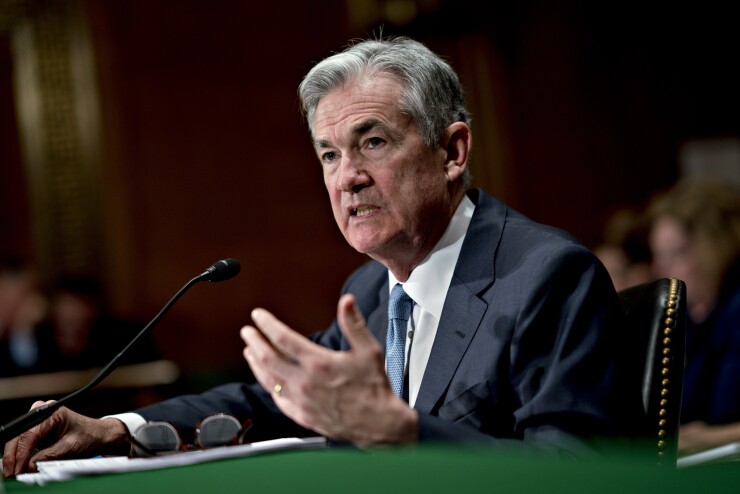While Federal Reserve Chair Jerome Powell stuck to the script in prepared remarks, the most telling part of his appearance before the Joint Economic Committee was when he refused to commit to the fed funds rate staying where it is for the next year.

"The Committee has stated that we do not expect it will be appropriate to reduce the target range for the federal funds rate until we have gained greater confidence that inflation is moving sustainably toward 2%."
When asked if the rate would be maintained for a year, Powell responded that policy is in a good place and changes will be data-driven. So the question becomes is he contemplating more or less accommodation in the coming year.
Looking at the latest Summary of Economic Projections, or dot plot, no Fed official predicted rates falling lower than the current 1.5% to 1.75% range. Of course, those projections were made in September and the next meeting (Dec. 10-11) will bring updated forecasts.
“Chairman Powell did not want to commit to a specific policy in responding to the question,” said Arthur Bass, managing director of fixed income financing, futures and rates at Wedbush. “One of the reasons the Fed changed the language in their most recent statement from ‘act as appropriate to sustain the expansion’ to ‘assesses the appropriate path of the target range for the federal funds rate’ was to give themselves more flexibility in carrying out policy. It makes sense that Chairman Powell would not want to give away that flexibility in a response to a question following his testimony. At this point, I think the Fed truly is data dependent.”
"Powell does not want to commit the Fed," said Mickey Levy, Berenberg Capital Markets' chief economist for the U.S. Americas and Asia. "The Fed is very pleased the market expectations are for no policy change in near term."
While trade policy and global uncertainties caused the Fed to "temporarily abandon data dependence ..it wants once again to be data dependent," he said. "As long as inflation is below the Fed’s 2% target, the Fed will be flexible, with a general tilt against downside risks. It will not raise rates in response to a moderate pickup in growth or rising inflation, but it would cut rates again if the data pointed toward material economic weakness. However, it has less incentive to ease further simply because the real Fed funds rate is virtually zero."
Edward Moya, senior market analyst at OANDA, agreed. “Powell does not want to handcuff the Fed’s next move,” he said. “Until we have a clearer outlook for growth abroad and trade developments, we probably will see the Fed remain noncommittal as to what will be their next policy move.”
His statement, “the U.S. economy can operate at a much lower level of unemployment than many would have thought,” Moya said, “seems rather dovish and possibly implies they regret the last couple of rate hikes in 2018.”
“Powell likely believes more cuts will be warranted in 2020 as too many risks to the global outlook will likely remain in place,” Moya added. “Deflation is also big risk and he has already delivered hints that they will launch further measures in the future.”
“Powell is right not to commit to leaving rates unchanged for a year," said Nicholos Venditti, portfolio manager and managing director, Thornburg Investment Management. "Should an economic slowdown appear, the Federal Reserve has to do their best to combat one. I think Powell and the members of the Fed are acutely aware that they have severely limited their ability to be effective when they need to be because they have kept rates artificially low during a time of incredible economic expansion.”
“Based on what we know at the moment about the economy and trade war the Fed is on hold," said Hugh Nickola, head of fixed income at GenTrust.
“Powell would never say 'commit' when it comes to rate changes. They will always be data dependent so that they can respond to unforeseen events.”
Dec Mullarkey, the head of investment strategy for SLC Management, noted, "Below target inflation is a concern for the Fed and ongoing trade negotiations with China leave ample room for setbacks and growth scares leading into next year. The Fed needs monetary policy to be as flexible as possible so it can cut rates to stoke inflation or offset trade disruptions. "
In his testimony, Powell said the Fed expects “sustained expansion of economic activity, a strong labor market, and inflation near our symmetric 2% objective as most likely.” Risks to the outlook come from “sluggish growth abroad and trade developments.”
Monetary policy should “remain appropriate” at current levels, he said, “as long as incoming information about the economy remains broadly consistent with our outlook of moderate economic growth, a strong labor market, and inflation near our symmetric 2% objective.” If developments result in the need for “a material reassessment of our outlook, we would respond accordingly,” he said. “Policy is not on a preset course.”
Inflation
The consumer price index rose 0.4% in October after a flat read in September, while the core rate grew 0.2% after a 0.1% rise the month before, the Labor Department reported Wednesday.
Year-over-year CPI was up 1.8% while the core was 2.3% higher than a year ago.
Economists polled by IFR Markets expected rises of 0.3% in the month and 1.7% year-over-year for the headline read, and core up 0.2% in the month and 2.4% year-over-year.
“Despite the modest deceleration in core consumer inflation, the Fed is expected to leave interest rates unchanged for the remainder of this year,” said Scott Anderson, chief economist at Bank of the West.
BNP Paribas' U.S. team of economists Joel Alcedo and Andrew Schneider, agreed: “Unless this profile materially raises inflation expectations, we do not expect this to meaningfully change the Fed’s stance.”





